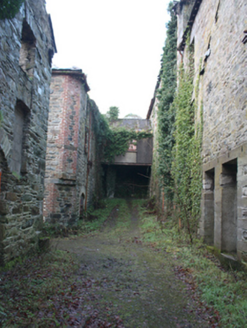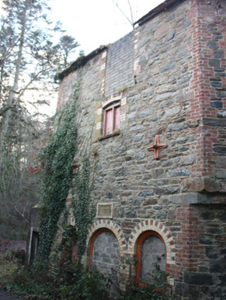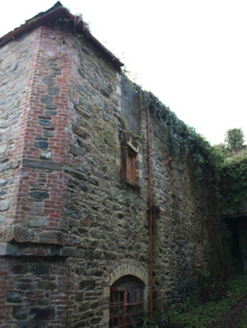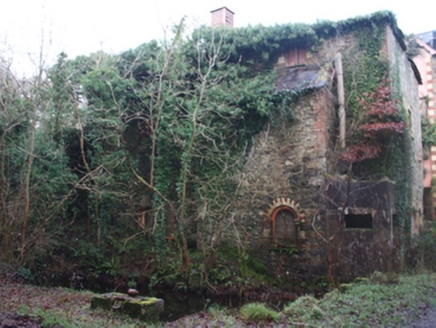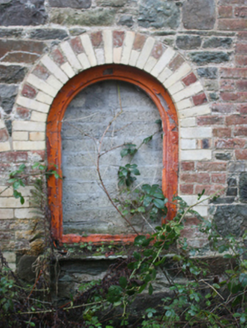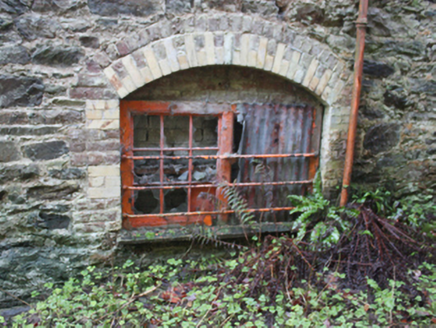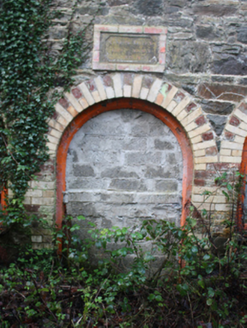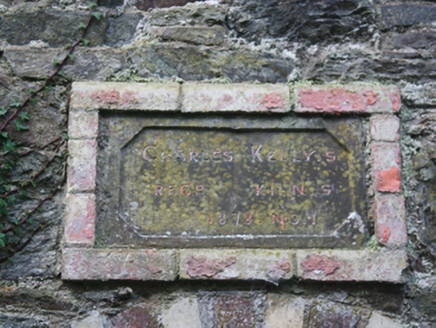Survey Data
Reg No
40800303
Rating
Regional
Categories of Special Interest
Architectural, Technical
Previous Name
Rathmelton Mill
Original Use
Kiln
Date
1870 - 1875
Coordinates
221724, 421018
Date Recorded
09/06/2014
Date Updated
--/--/--
Description
Formerly detached three-bay three-storey former corn drying kiln, dated 1873, having advanced single-bay block to the south elevation, later single-storey additions, and with single-bay single-storey over basement block to the north-east corner, added c. 1940. Canted corner to the north-east. Possibly incorporating earlier fabric of building to site that was extant in 1834 (Ordnance Survey first edition sic-inch map). Now out of use and derelict. Pitched natural slate roof having roof vent to apex with hipped metal roof and remains of timber louvered fittings. Mono-pitch natural slate roof to projection to the south. Some surviving sections of cast-iron rainwater goods. Roughly dressed rubble stone walls having flush red brick block-and-start quoins to the corners, cast-iron tie bar\pattrice plates and wrought-iron tie bars, and with inset stone plaque to the west elevation having inscription 'CHARLES KELLYS REGD KILNS 1873 No.1' with painted brick surround. Round- and shallow segmental-headed window openings having polychromatic red and yellow brick surrounds and voussoirs, and remains of timber frames. Ground floor window openings now infilled with modern blockwork. Window openings to the west and north elevations at first floor level having battened timber shutters with central timber mullion; window opening to the north elevation at ground floor level having cast-iron fittings. Located in the rural countryside to the west of Ramelton town centre. Located on the north bank of Leannan River adjacent to the south-east of Drummonaghan Bridge (see 40800210) and former mill weir (see 40823002). Earlier mill building adjacent to the east (see 40800301) and contemporary store adjacent to the north (see 40800303). Located adjacent to the north bank of the former head race serving mill. Sluice formerly controlling flow of water along headrace to waterwheel(s) adjacent to the south.
Appraisal
This interesting former corn drying kiln forms part of an interesting collection of structures associated with Kelly’s Mils (see 40800301 and 40800302 for other structures in complex) that together constitute an important element of the industrial heritage of the Ramelton area. It is robustly constructed in rubble stone masonry and survives in relatively good condition, despite years of disuse, which is testament to the quality of its original construction. Modest decorative interest is added by the colourful polychromatic brick detailing to the openings and the brick quoins to the corners. The contrast between the sober grey stonework and the brick detailing creates attractive tonal and textural variation, and is a feature of many industrial and agricultural building constructed in Ireland during the second half of the nineteenth century (and into the twentieth century). The survival of the roof vents is an interesting feature that indicates its original function as a drying kiln. A stone plaque to the east elevation records that it was built by a Charles Kelly in 1873. It may incorporate the fabric of an earlier structure to site that was extant in 1834 (Ordnance Survey first edition six-inch map). This structure was originally built to serve the existing flour\corn mill (see 408000301) adjacent east. It is a relatively rare example of a corn kiln that was built in the rural Irish countryside during the second half of the nineteenth. The rural corn mill industry went into serious decline in Ireland from c. 1820 and, during the second half of the nineteenth, became increasingly concentrated in the ports of the larger cities in Ireland, as can be seen in Dublin, Cork and Waterford. This indicates that this was a highly successful milling enterprise with its proximity to the port at Ramelton probably playing a large part in its prosperity. The existing milling buildings to site were originally established by James Watt around 1812. Watt also constructed a fine residence called The Green (see 40800305) a short distance to the east of this site. The Ordnance Survey Memoirs of 1834 record that the mill was in the ownership of Mr. Watt. It was later apparently purchased by the Kelly family in 1846 (James Watt of nearby Claragh House is listed as the owner of the mills in Slater’s Directory of 1846), although some sources suggest that in 1876 Edward Kelly, a former clerk in David Watt’s distillery in Derry, went into partnership with Watt, and subsequently took ownership of the mills. The plaque to site indicates that a Charles Kelly was probably responsible for the construction of this structure. It was in the ownership of Edward and Ellen Kelly in 1881, when it was known as Rathmelton Corn Mills. Slater’s Directories of 1846 and 1881 record that around Ramelton ‘the trade in corn is considerable, and there are some large mills in the vicinity’. The mill remained in use until 1972 when it finally closed. This former industrial building is of considerable social and economic significance to the local community, and forms part of a complex that would have employed a considerable work force in its heyday. This building stands as a symbol of the physical impact of large-scale industry on the rural landscape, and is an interesting feature on the scenic rural landscape to the west of Ramelton. It forms part of a group of related structures along with the remains of the earlier mill adjacent to the east (see 40800301), the former store to the north (see 408003032, the weir (40823002) and bridge (40800210) to the north-west, and the head and tailraces.
